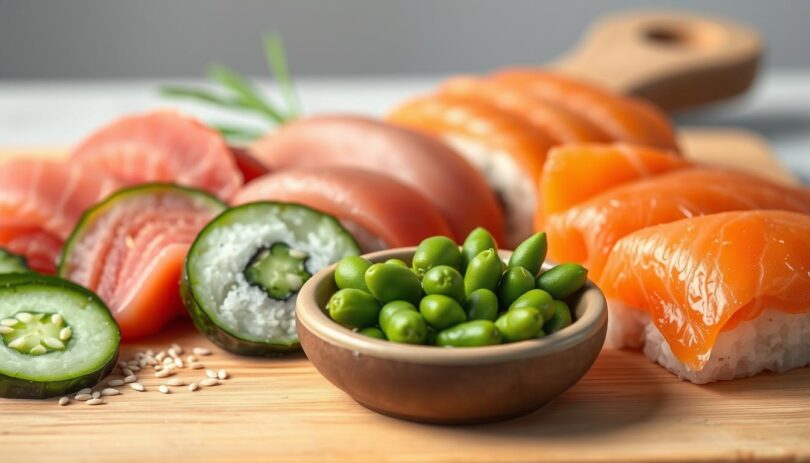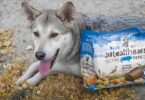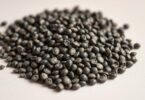Over 45 million Americans enjoy sushi regularly, but few consider how this trend impacts their pets. As adventurous eaters share meals with furry companions, questions about safety and nutrition arise. While some sushi components offer nutritional value, others pose hidden dangers for animals.
Human-grade dishes often include ingredients like rice, seaweed, and fish—elements that may seem harmless. However, a pet’s digestive system processes foods differently. For example, avocado in rolls contains persin, a toxin for animals. Soy sauce’s high sodium levels also risk dehydration or salt poisoning.
Raw fish introduces another layer of concern. Bacteria like salmonella thrive in uncooked proteins, potentially causing severe illness. Even cooked fish requires careful preparation to avoid bones or seasoning. Owners must weigh the benefits of omega-3 fatty acids against these hazards.
This article explores how specific ingredients affect canine health. It outlines safe practices for sharing sushi-inspired treats and highlights critical red flags. From portion sizes to breed-specific advice, readers will learn to balance curiosity with caution.
Understanding Sushi and Its Components
Sushi combines simple elements into complex flavors, but each component carries specific considerations for pet safety. This Japanese dish relies on three foundational items: seasoned rice, fresh seafood, and nutrient-rich seaweed. Let’s examine these building blocks and their suitability for canine diets.
Key Ingredients: Rice, Fish, and Seaweed
White rice provides carbohydrates for energy but lacks fiber. Short-grain varieties are sticky and easy to digest, though portion control matters. Fish delivers lean protein and omega-3 fatty acids, which support skin and coat health. Always remove bones to prevent choking hazards.
Seaweed contains iodine and antioxidants. Nori sheets offer a crunchy texture pets might enjoy. However, seasoning blends often include salt or spices unsuitable for animals.
Vegetables and Condiments in Sushi
Cucumber and carrots add vitamins without risks. Avoid avocado due to persin toxicity. Wasabi and soy sauce irritate sensitive stomachs. High sodium levels in these sauces may lead to dehydration or kidney strain.
Raw seafood poses bacterial threats like salmonella. Cooking eliminates pathogens but requires plain preparation—no oils, butter, or garlic. Steamed options reduce risks while preserving nutritional benefits.
Nutritional Benefits and Health Risks for Dogs
While sushi offers a blend of nutrients, pet owners must weigh these against potential hazards. Certain ingredients provide valuable vitamins and minerals, but preparation methods significantly impact safety. Let’s explore how to maximize benefits while minimizing threats.
Essential Nutrients From Sushi Ingredients
High-quality protein in fish supports muscle development and energy levels. Omega-3 fatty acids promote healthy skin and reduce inflammation. Cooked salmon, when deboned and plain, becomes a safe source of these nutrients. Rice offers digestible carbohydrates, while seaweed provides iodine for thyroid function.
Vitamins like B12 and D3 in fish aid metabolism and bone strength. For tailored guidance on safe salmon preparation, consult veterinary resources. Always prioritize plain, unseasoned versions of these ingredients.
Potential Dangers: Bacteria, Parasites, and Toxins
Raw fish carries risks like salmonella and parasites. These pathogens cause vomiting, diarrhea, or severe digestive issues. Certain species like tuna may contain mercury, harming the nervous system over time.
Undercooked salmon might host parasites leading to fatal conditions. Symptoms like lethargy or appetite loss require immediate vet attention. Proper cooking eliminates most threats but avoid oils or spices during preparation.
Balance is key: occasional sushi-inspired treats can complement a diet when prepared thoughtfully. Always discuss new foods with your veterinarian to safeguard your pet’s health.
Can Dogs Eat Sushi? Safe Practices and Considerations
Moderation transforms human favorites into pet-safe indulgences when handled properly. Sharing sushi-inspired snacks requires strict adherence to preparation rules and quantity limits. This approach minimizes health risks while allowing occasional culinary exploration.
Guidelines on Portion Control and Feeding Frequency
Treats shouldn’t exceed 10% of a pup’s daily calories. For small breeds like Chihuahuas, offer rice-sized pieces once weekly. Larger dogs like Labradors may handle two thumb-sized rolls monthly. Always remove soy sauce and avocado before serving.
Cooked fish like salmon provides protein and fatty acids without raw-meat dangers. Chop ingredients into pea-sized bits to prevent choking. Steamed vegetables add crunch but skip spicy condiments that upset digestion.
Overfeeding causes weight gain or nutrient imbalances. Even safe foods become hazardous in excess. Watch for lethargy or stomach issues after introducing new items. Schedule vet consultations to confirm portion plans align with your companion’s needs.
Raw seafood introduces parasites and bacteria, so stick to fully cooked options. Store leftovers immediately and discard uneaten portions within two hours. Balance curiosity with caution to keep meals enjoyable and risk-free.
Preparing and Serving Sushi for Your Dog
Creating canine-safe sushi requires careful ingredient selection and portion management. Start with plain, fully cooked proteins and unseasoned components to ensure nutritional benefits without hidden risks. This approach lets pets enjoy novel textures while supporting their well-being.
How to Prepare Dog-Friendly Sushi
Begin by steaming salmon or whitefish until flaky, removing all bones. Use cooled short-grain rice without vinegar or salt. Layer thinly sliced cucumber or carrot atop a nori sheet, then add rice and shredded fish. Roll tightly and slice into bite-sized pieces.
Avoid sauces, spices, or avocado entirely. Fresh ingredients minimize bacterial threats and aid digestion. Store leftovers in airtight containers for up to two days, discarding any uneaten portions promptly.
Serving Sizes Based on Dog Breeds and Sizes
For extra-small breeds under 10 pounds, offer one pinky-sized piece weekly. Medium pets like Beagles handle a quarter roll per serving. Large companions such as German Shepherds can enjoy half a roll monthly, divided into smaller segments.
Adjust portions based on activity levels and dietary needs. Always introduce new foods gradually, monitoring for allergic reactions. Consult a veterinarian to tailor recipes for specific health conditions or weight goals.
Alternatives to Traditional Sushi for Dogs
Pet owners seeking to share mealtime excitement without hazards can explore creative, safe substitutes. These options maintain the fun of sharing while prioritizing nutritional balance and safety. Simple ingredient swaps eliminate risks like bacterial contamination or toxic additives found in human-grade dishes.
Homemade Dog-Friendly Sushi Recipes
Try this protein-packed roll: mix cooled cooked salmon with plain white rice. Wrap in thinly sliced cucumber instead of seaweed. Add shredded carrots for crunch and vitamin A. Slice into bite-sized pieces for easy chewing.
This recipe skips avocado and soy sauce entirely. It delivers omega-3 fatty acids from fish and fiber from vegetables. Preparation takes under 15 minutes, making it ideal for busy owners.
Other Healthy Treat Options
Lean proteins like boiled chicken or turkey cubes offer similar benefits to sushi-grade fish. Frozen banana slices or blueberries create refreshing snacks. These choices avoid raw fish risks while supporting digestion and hydration.
Compared to traditional rolls, homemade versions reduce sodium by 90% and eliminate parasites. They still provide essential vitamins and minerals. Rotate ingredients weekly to keep meals interesting without compromising health standards.
Always consult your veterinarian before introducing new foods. Track your companion’s reactions to ensure these alternatives align with their dietary needs.
Common Ingredients to Avoid in Dog Sushi
Pet owners crafting homemade rolls often overlook hidden dangers in seemingly harmless ingredients. Three common sushi components pose significant threats to canine health, requiring strict exclusion from recipes.
Unsafe Add-ons: Avocado, Soy Sauce, and Raw Fish
Avocado contains persin, a toxin causing vomiting and pancreatitis in animals. Even small amounts in sushi rolls risk serious digestive issues. Soy sauce’s extreme sodium levels strain kidneys and may trigger dehydration or seizures.
Raw fish introduces parasites like tapeworms and bacteria such as salmonella. These pathogens lead to diarrhea, lethargy, or life-threatening infections. Tuna carries additional mercury risks, harming nervous systems over time.
Watch for symptoms like excessive thirst, tremors, or loss of appetite after accidental ingestion. Immediate veterinary care becomes crucial if these signs appear. Always choose cooked proteins and unseasoned vegetables for safe alternatives.
Prioritize simplicity: skip sauces, spices, and human-grade garnishes. Focus on plain ingredients that support nutrition without hidden hazards. This approach keeps meals enjoyable while protecting your companion’s well-being.
Wrapping Up Your Dog’s Sushi Experience
Sharing culinary adventures with pets requires balancing enthusiasm with safety. Nutrient-rich ingredients like cooked fish and rice offer protein and vitamins when prepared plainly. Always prioritize fresh, unseasoned components to support skin health and digestion.
Hazardous additives lurk in human-grade rolls. Avoid raw fish carrying parasites and bacteria. Skip soy sauce’s sodium overload and avocado’s toxic persin—these trigger serious health risks despite their appeal to humans.
Tailor portions to your companion’s size. Small breeds thrive with pea-sized treats weekly, while larger pets handle thumb-length servings monthly. Watch for unusual behavior like lethargy or diarrhea after introducing new foods.
Consult your veterinarian before crafting homemade recipes. They’ll confirm portion guidelines and identify breed-specific needs. With careful planning, occasional sushi-inspired snacks can become joyful bonding moments without compromising long-term wellness.
Celebrate your pet’s curiosity through safe, intentional treats. Prioritize their health while exploring creative culinary connections—the key lies in mindful moderation.
FAQ
Can salmon in sushi benefit a dog’s health?
Cooked salmon provides omega-3 fatty acids for skin and coat health, but raw versions risk salmonella. Opt for plain, deboned, and steamed fillets without seasoning. Avoid teriyaki-glazed or smoked varieties with added sugars.
How often can pups safely consume sushi-inspired meals?
Limit treats to 10% of daily calories. For a 20-pound pet, offer 1-2 small bites weekly. Use sushi as occasional enrichment, not a dietary staple, to prevent nutrient imbalances or weight gain.
What sushi ingredients pose risks to pets?
Raw fish may contain parasites like anisakis, while soy sauce’s high sodium content strains canine kidneys. Avocado (common in rolls) contains persin, a toxin causing digestive issues. Always skip wasabi and spicy mayo due to irritation risks.










Leave a Comment